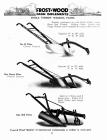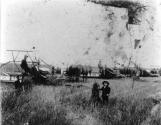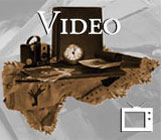1
Keeping the company's name in public view was always a priority for the Frost & Wood Company.When advertising, the company always found different ways to let consumers know that buying a piece of Frost & Wood machinery would lessen the burden of the harvest and put more money in the farmer's pockets.
Over the years, Frost & Wood created a wide inventory of reliable and popular products such as plows, mowers, binders, disc harrows, cook-stoves, cauldrons, reapers and, dump rakes. The company also ensured extra parts were always available, which added to the company's reputation for being a reliable producer of durable machinery.
"Dear Sirs: I bought from your agent here a Frost & Wood Mower, and I must say it is the best and the easiest running machine I ever used in making hay. Other mowers I have tried will clog in wet, matted grass, but this one never does. I like it fine. Yours Sincerely, F.W. Godfrey" (The Last Record Crop, c. 1919).
2
Frost & Wood Machinery: Made in CanadaCirca 1904
Smiths Falls, Ontario, Canada
 Credits:
Credits:Heritage House Museum
3
The horse-drawn plow was one of Frost & Wood's biggest sellers across Canada.The body of a plow was originally made from wood, but manufacturers eventually turned to cast iron. Wear and breakage of a plow's mouldboard was a common problem until the 1830s when cast iron was phased out in favour of steel. A steel share and mouldboard allowed the plow to glide through soil that had previously thought too ill-suited to farm.
Foundries in Canada and the United States began manufacturing 'chilled plows' in 1842. The wearing parts of the plow were made of chilled steel, which meant there was a glassy finish to the part of the plow that came into contact with the soil. This glassy finish reduced the plow's draft by 25-30 percent.
By 1876, a Frost & Wood plow could be bought for $15.00 to $17.00.
4
Frost & Wood Equipment: PlowsCirca 1938
Smiths Falls, Ontario, Canada
 Credits:
Credits:Heritage House Museum
5
Used for cutting hay, the horse-drawn Number 8 Mower was well-liked by farmers and was marketed as part of the Frost & Wood's 'Quality Line' in the 1850s."Delays are serious and affect the quality and volume of a ripe crop, so insist on having a Mower on which you can depend. The Frost & Wood won't fail you at your busiest season." (Frost & Wood Farm Machinery Catalogue, c. 1938, page 49).
By the 1930s, Frost & Wood was manufacturing the Regular Mower, which was built as 4' 6" or 5' size with Standard or Vertical lift and the Giant Mower in a 5', 6' or 7' size. The company ensured farmers that both models were light-draft machines with dependable traction and perfectly aligned cutter bars. This allowed for a quicker response at the knife bar, and less wear on the gears and thus lower repair bills for the owner.
In the 1870s, a Frost & Wood mower cost approximately $80.00.
7
In this silent video, a farmer uses an oil bath mower out in the field. By the 1930s, Frost & Wood had become a division of the Cockshutt Plow Company.9
The first mention of Frost & Wood producing binders was in 1884. The binders had 'knotter' mechanisms and used wire or twine to tie the gathered grain into bundles.Frost & Wood actively marketed their binders as products that could save a farmer time and money. The company made sure to keep spare equipment parts in stock always to prevent any delays when it came to harvesting, which in turn, only furthered their reliable reputation.
Like the company's other products, Frost & Wood promised any farmer who bought a binder from the company would be impressed with its combination of strength, durability and light draft when out in the field.
10
Frost & Wood Equipment: Binders19th Century
 Credits:
Credits:University of Guelph Archival & Special Collections.
11
Advertisements for binders sometimes used words like 'magic' because Frost & Wood was sure their binders could accomplish as much work as seven men using sickles could out in the field.In this silent movie, a farmer uses a Cockshutt Plow Company binder out in the field.
13
In the mid 1800s, Frost & Wood was not the only farm equipment company in Smiths Falls. However, as Frost & Wood continued to dominate the local market, smaller companies were often bought up, or left town. The Cossit Brothers Company had been the main competition for Frost & Wood for years. It was predicted that at the height of the Cossit Bros. production, along with Frost & Wood, the two companies employed half of the population of Smiths Falls.In 1862, Frost & Wood began selling Buckeye Mowers. The Buckeye had a wooden frame and came with an attachment that could convert the machine into a reaper. The Cossit Bros. also manufactured the Buckeye Mower, and sued Frost & Wood for patent infringement. Employees from Frost & Wood claimed to have obtained the patterns from colleagues in the United States. Though the patents for the machinery were legal in the U.S., they were void in Canada, thus allowing anyone to use them.
The court was unconvinced and allowed Frost & Wood to continue manufacturing the Buckeye Mowers. Soon after, Frost & Wood began manufacturing adaptations to the Buckeye like the Buckeye Harvester Self-Rake Reaper and the Daisy reaper. By the 1870s, The Cossit Bros. relocated to Brockville and left Frost & Wood to dominate the local market.
14
Frost & Wood Equipment: The Buckeye MowerCirca early 1900s
Cornwall, Ontario, Canada
 Credits:
Credits:Johnston, Bruce

